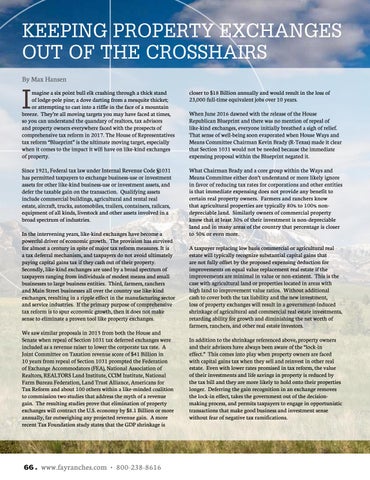KEEPING PROPERTY EXCHANGES OUT OF THE CROSSHAIRS By Max Hansen
I
magine a six point bull elk crashing through a thick stand of lodge-pole pine; a dove darting from a mesquite thicket; or attempting to cast into a riffle in the face of a mountain breeze. They’re all moving targets you may have faced at times, so you can understand the quandary of realtors, tax advisors and property owners everywhere faced with the prospects of comprehensive tax reform in 2017. The House of Representatives tax reform “Blueprint” is the ultimate moving target, especially when it comes to the impact it will have on like-kind exchanges of property.
closer to $18 Billion annually and would result in the loss of 23,000 full-time equivalent jobs over 10 years.
Since 1921, Federal tax law under Internal Revenue Code §1031 has permitted taxpayers to exchange business-use or investment assets for other like-kind business-use or investment assets, and defer the taxable gain on the transaction. Qualifying assets include commercial buildings, agricultural and rental real estate, aircraft, trucks, automobiles, trailers, containers, railcars, equipment of all kinds, livestock and other assets involved in a broad spectrum of industries.
What Chairman Brady and a core group within the Ways and Means Committee either don’t understand or more likely ignore in favor of reducing tax rates for corporations and other entities is that immediate expensing does not provide any benefit to certain real property owners. Farmers and ranchers know that agricultural properties are typically 80% to 100% nondepreciable land. Similarly owners of commercial property know that at least 30% of their investment is non-depreciable land and in many areas of the country that percentage is closer to 50% or even more.
In the intervening years, like-kind exchanges have become a powerful driver of economic growth. The provision has survived for almost a century in spite of major tax reform measures. It is a tax deferral mechanism, and taxpayers do not avoid ultimately paying capital gains tax if they cash out of their property. Secondly, like-kind exchanges are used by a broad spectrum of taxpayers ranging from individuals of modest means and small businesses to large business entities. Third, farmers, ranchers and Main Street businesses all over the country use like-kind exchanges, resulting in a ripple effect in the manufacturing sector and service industries. If the primary purpose of comprehensive tax reform is to spur economic growth, then it does not make sense to eliminate a proven tool like property exchanges. We saw similar proposals in 2015 from both the House and Senate when repeal of Section 1031 tax deferred exchanges were included as a revenue raiser to lower the corporate tax rate. A Joint Committee on Taxation revenue score of $41 Billion in 10 years from repeal of Section 1031 prompted the Federation of Exchange Accommodators (FEA), National Association of Realtors, REALTORS Land Institute, CCIM Institute, National Farm Bureau Federation, Land Trust Alliance, Americans for Tax Reform and about 100 others within a like-minded coalition to commission two studies that address the myth of a revenue gain. The resulting studies prove that elimination of property exchanges will contract the U.S. economy by $8.1 Billion or more annually, far outweighing any projected revenue gain. A more recent Tax Foundation study states that the GDP shrinkage is
66 • www.fayranches.com • 800-238-8616
When June 2016 dawned with the release of the House Republican Blueprint and there was no mention of repeal of like-kind exchanges, everyone initially breathed a sigh of relief. That sense of well-being soon evaporated when House Ways and Means Committee Chairman Kevin Brady (R-Texas) made it clear that Section 1031 would not be needed because the immediate expensing proposal within the Blueprint negated it.
A taxpayer replacing low basis commercial or agricultural real estate will typically recognize substantial capital gains that are not fully offset by the proposed expensing deduction for improvements on equal value replacement real estate if the improvements are minimal in value or non-existent. This is the case with agricultural land or properties located in areas with high land to improvement value ratios. Without additional cash to cover both the tax liability and the new investment, loss of property exchanges will result in a government-induced shrinkage of agricultural and commercial real estate investments, retarding ability for growth and diminishing the net worth of farmers, ranchers, and other real estate investors. In addition to the shrinkage referenced above, property owners and their advisors have always been aware of the “lock-in effect.” This comes into play when property owners are faced with capital gains tax when they sell and reinvest in other real estate. Even with lower rates promised in tax reform, the value of their investments and life savings in property is reduced by the tax bill and they are more likely to hold onto their properties longer. Deferring the gain recognition in an exchange removes the lock-in effect, takes the government out of the decisionmaking process, and permits taxpayers to engage in opportunistic transactions that make good business and investment sense without fear of negative tax ramifications.
